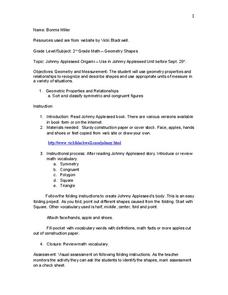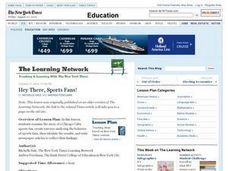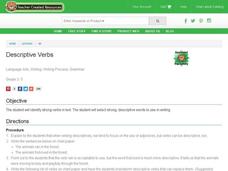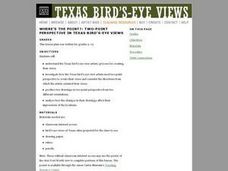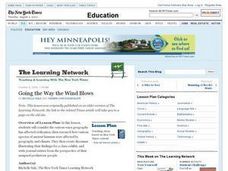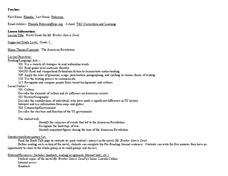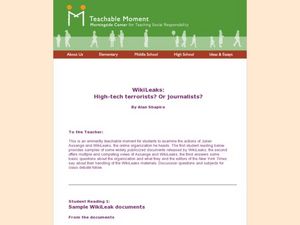Curated OER
Billy Brown and The Belly Button Beastie
Students read and discuss the book, Billy Brown and the Belly Button Beastie. In this children's literature lesson, students read the book and participate in a discussion about the sequence of events in the text. Students create a...
Curated OER
Eating Healthy
Students review healthy eating habits, and demonstrate reading comprehension skills, including reading strategies, inference, literal meaning, and critical analysis.
Curated OER
Automated Intelligence
Learners redesign everyday robotic devices to increase their autonomy and their usefulness. Propose ideas that would make directly controlled robotic devices more antonymous and create posters illustrating their ideas.
Curated OER
Life During the Civil War for Women and Civilians
Young scholars follow an overview of the American Civil War from a film, the text and/or teacher direct instruction. They create a timeline with a large map of the U.S. in the 1860's available for student reference as they do the spider...
Curated OER
Tiananmen Square
Young scholars identify and explain the Tiananmen Square incident of June 1989.
Studentsl compare what it is to be an American Citizen (Democracy) vs.
Chinese Citizen (Communism). Young scholars identify and define various vocabulary...
Curated OER
Action and Linking Verbs
In this recognizing action verbs and linking verbs in sentences worksheet, students read statements, identify the verbs, and label them either action or linking verbs. Students write 15 answers.
Curated OER
Johnny Appleseed Origami
Second graders make an origami Johnny Appleseed. In this geometry lesson students follow folding instructions. They find different geometric shapes while they are folding. They create Johnny Appleseed's body and attach a face and hands...
Curated OER
Taming the Wild Aurochs
Sixth graders read and discuss the domestication of animals in history. In this Aurochs reading lesson, 6th graders define vocabulary and list similarities and differences between wild and domesticated animals. Students complete an...
Curated OER
Farm Mobile
Second graders are given a variety of materials to communicate the symbols of farm life. They create a mobile utilizing the given materials depicting farm life and following step-by-step instructions correctly. Students also read the...
Curated OER
Where Do Things Come From?
Second graders examine the recycling process. In this recycling lesson, 2nd graders discuss the reasons for recycling and create storyboards to show where a specific material comes from. Students complete a worksheet as a follow-up...
Curated OER
1930 Census and the Consitution
Students read the Constitution and discuss the importance of enumeration. In this Census lesson, students complete a Census schedule and discuss the job skills of applicants. Students research Census data to compare and contrast the...
Curated OER
Medicine: Then and Now
Students read ancient Greek texts to explore ancient healing practices and compare them to modern-day medicine. They conduct research into modern first-aid practices, using a standard medical reference.
Curated OER
Hey There, Sports Fans!
Students discuss the impact that fans have on a sports team. After reading an article, they identify how Chicago Cubs fans are responding to their loss in the playoffs. With a partner, they develop surveys in which they give to family...
Curated OER
Quick Breads, Biscuit Method Lab
Students watch the teacher demonstrate following the biscuit recipe. They follow the recipe themselves and prepare bread sticks and cinnamon rolls. While their breads are cooking, students work the provided crossword puzzle.
Curated OER
Measuring Temperature
Students examine how to determine temperature on a thermometer. They read and discuss an informational handout, discuss examples of Fahrenheit and Celsius scales, and complete a worksheet.
Curated OER
Descriptive Verbs
Young scholars read a piece of literature and locate the descriptive verbs in the piece. For this descriptive verbs lesson, students understand the value of using descriptive verbs. Young scholars rewrite a story they've written with...
Curated OER
Language, As Experienced Through Pin-Hole Photography
Students read about and discuss photographic principles and, under the direction of the art teacher, construct individual cameras from heavy black cardboard and thin sheet metal with a hole for the lens and black tape for the shutter.
Curated OER
On the Road with Marco Polo
Young scholars follow Marco Polo's route to and from China. They explore the geography, local products, culture, and fascinating sites of those regions. They record their findings.
Curated OER
You Can't Stop The Pop
Young scholars reflect on the popular culture of their own country and explore the "Korean Wave" of popular culture in East Asia. They research the popular cultures of various countries around the world and present their findings in an...
Curated OER
Where's the Point?: Two-Point Perspective in Texas Bird's-Eye Views
Students investigate how the Texas bird's-eye-view artists used two-point perspective to create their aerial views and consider the directions from which the artists oriented their views. They produce two drawings in tow-point perspective.
Curated OER
Summarizing
Fourth graders listen to the teacher discuss the definition of "Summary." They read a story aloud with their classmates. After finishing the story, 4th graders are asked to choose the best summary statement.
Curated OER
Going the Way the Wind Blows
Students examine the cause and effect relationship between geography and ancient civilizations. After reading an article, they determine how new findings can help scientists examine the migration patterns of these civilizations. Using...
Curated OER
Novel Guide for My Brother Sam is Dead
Fifth graders explore the effects of war. In this American Revolution instructional activity, 5th graders read My Brother Sam is Dead and complete the provided comprehension, characterization, and vocabulary activities
Curated OER
WikiLeaks: High-tech terrorists? Or Journalists?
Students investigate the credibility of WikiLeaks. In this history lesson plan, students read three WikiLeak articles, then answer questions that relate to each article.






